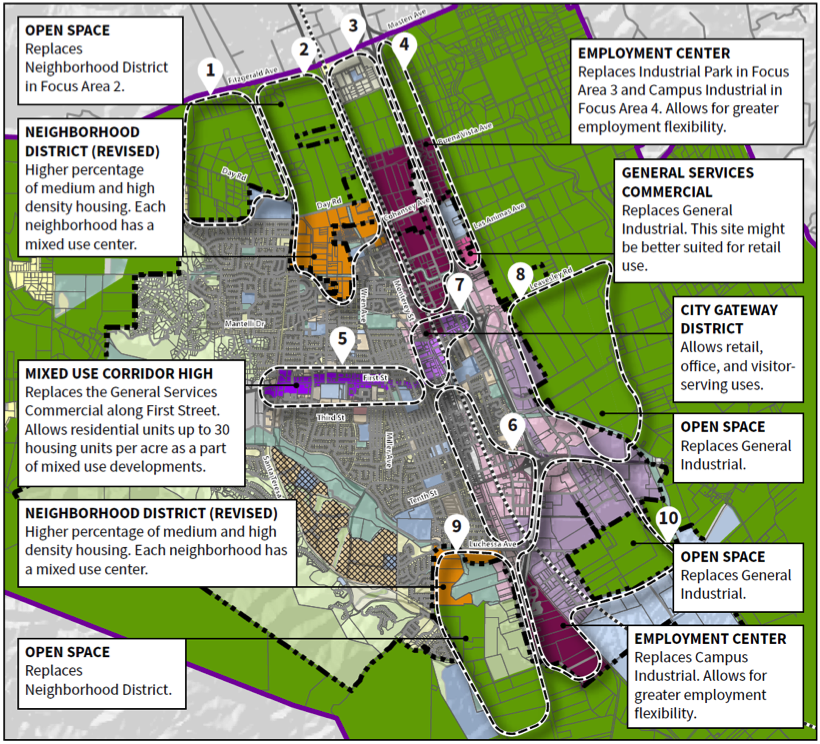
GILROY—In a split vote Monday that rejected much public sentiment and planning commission advice, the Gilroy City Council embraced urban growth far beyond city limits while at the same time preserving a big swath of prime farmland.
The 4-3 decision was a victory for open space advocates who wanted 660 acres of farmland, roughly a square mile, east of the outlet malls left undeveloped, but it disappointed others who argued for compact growth and accused the council majority of ignoring what most citizens want and the unanimous advice of its own planning commission.
Mayor Don Gage voiced the majority view when he made his vision of Gilroy circa 2040 clear: “The reality is our growth has occurred in the north and southwest quads. That’s where we continue to see residential growth and I’d like to see the 660 acres as open space; I’m not interested in making that industrial.”
That reasoning did not fly with Councilman Dion Bracco, who, with fellow Council Members Cat Tucker and Roland Velasco, refused to buy into Gage’s expansive vision of the future and accused the majority of ignoring fiscal realities and the wishes of the public.
We have streets we can’t maintain now because we don’t have the money to maintain them, and to think about adding more streets we can’t maintain just doesn’t make any sense,” Bracco said after nearly an hour of public comment.
“I haven’t heard any of them (citizens) get up and say ‘we want to build more houses everywhere.’ Our community is talking to us and I think we need to listen to them,” he said.
The dissenters aligned themselves with the planning commission’s unanimous endorsement earlier this month of compact growth, open space and a halt to northern expansion at Day Road, not nearly as far north as the Masten/Fitzgerald avenues boundary.
The 720 acres, or about 1.12 square miles, between those two east-west roads are under city review for possible annexation if adding the parcel to the city’s urban boundary is approved the Local Agency Formation Commission, LAFCO, the regional planning body that controls annexations.
The council vote in effect allows future residential and commercial development of the 720 acres, if it’s annexed, meaning urbanization north to Masten/Fitzgerald Avenue, comprising a majority of the 112 acres the decision would add to the city’s planning boundaries.
The council’s preferred land use map closely matches that of the GPAC, the 23-member volunteer, council-appointed body that two years ago began a study of future land use options and last month made its recommendation for the new general plan. That state-mandated document lays out the city’s plan of growth for the next 20 years. The planning commission altered much of the GPAC’s input before making its own recommendation to the council.
Still, GPAC Chair and Councilman Perry Woodward made the motion to approve the GPAC’s plan verbatim, which passed with Gage’s amendment to rid the land use plan of a GPAC-proposed employment center on farmland east of the outlet mall.
A majority of Gilroyans who spoke during the meeting either advocated for slower, more careful growth or approval of the planning commission’s recommendations.
“Take a slower growth approach to development. Think about it before we start building 1,000 homes here and 400 homes there,” Henry Coletto told the council.
Planning Commissioner and GPAC member Elizabeth Sanford said, “Gilroy is a wonderful place to live and we owe it to future generations to make sure it stays that way by approving only thoughtful, balanced growth.”
Others argued for the GPAC vision of Gilroy.
“The quality of jobs the city needs to attract will not be accomplished by in-fill development,” said Tammy Brownlow, president of the Gilroy Economic Development Corporation.
“Over 15,000 people leave Gilroy every day and head north. Don’t hinder our ability to reach our potential by approving a short-sighted vision for our community.”
Woodward said the General Plan is all about compromise and that, “One of the earmarks of a good compromise is that everyone is a little unhappy. Everybody has a little different vision on how the city ought to be laid out. This is a long-range planning effort and it’s about where we grow next.”
The council also endorsed development in so-called urban reserve areas, such as the 720 acres between Day Road and Fitzgerald Avenue, as long as certain conditions, yet to be determined, are met.
However, the planning commission and a majority of citizens who gave their input at community workshops, public meetings and in online surveys, compact development with minimal outward expansion.
“They (the council) totally disregarded what we had to say,” said Linda West, a Gilroy resident and downtown activist. “They should have considered what the public had to say in those community meeting groups. It was overwhelming that we have limited growth.”
Save Open Space Gilroy members David Lima and Connie Rogers liked that the council agreed to preserve the 660 acres of farmland.
Lima said he was heartened that three council members opposed the motion because of the proposed urban expansion into north-central Gilroy.
“I’m thrilled so many people took the time to stand up and speak,” Rogers said, adding the amount of public involvement in the current General Plan process far exceeded that of the prior update in the early 2000s. “Everyone will have an election soon enough.”
The council’s decision allows city staff and to begin preparation of the General Plan’s policy document, which will go to the GPAC and planning commission for review before final adoption by the city council in the spring of 2016.












